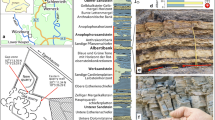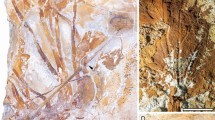Abstract
Pseudotsuga is an accessory element in the Neogene vegetation in Central Europe. Two species based on coalified seed cones and one species each based on leaves and wood have been described so far from Miocene and Pliocene localities, mainly in Germany. Based on a new seed cone record from the site of Wiesa in Germany, I describe here evidence supporting the extension of the stratigraphic range of Pseudotsuga jechorekiae Czaja, including the late early Miocene. An emended diagnosis is given and a neotype is proposed for the Pliocene Pseudotsuga loehrii comb. nov. The leaf record is revisited and critically evaluated as leaf cuticles previously determined as “Pseudotsuga oceanines” are reinterpreted herein as Tsuga or Nothotsuga. Subsequently, the late Oligocene presence of the genus in Central Europe exclusively based on “Pseudotsuga oceanines” remains doubtful. The fossil cone species are morphologically compared to the extant species, with the highest conformity found to the Asian species. Finally, palaeophytosociological, palaeoautecological and palaeoclimatic aspects of the fossil species are compiled.










Similar content being viewed by others
References
Blokhina NI, Bondarenko OV (2004) Fossil wood of Pseudotsugoxylon gen. et. spec. nov. (Pinaceae) from the Pliocene of the southern Primorskii Region. Paleontol J 3:23–35
Carrière E A (1867) Traité général des conifères. Ed. 2. Published by the author, Paris
Christenhusz MJM, Reveal JL, Farjon A, Gardner MF, Mill RR, Chase MW (2011) A new classification and linear sequence of extant gymnosperms. Phytotaxa 19:55–70
Chun WY, Kuang KZ (1962) De genere Cathaya Chun & Kuang. Acta Bot Sin 10(3):245–247
Cronquist A, Takhtajan A, Zimmermann W (1966) On the higher taxa of Embryobionta. Taxon 15:129–134
Czaja A (2000) Pseudotsuga jechorekiae sp. nova, der erste fossile Nachweis der Gattung Pseudotsuga Carriére nach Zapfen aus dem Miozän der Oberlausitz, Deutschland. Feddes Repert 111(3–4):129–134
Czaja A (2001) Koniferen aus dem Mittelmiozän der Tongrube Tetta-Buchholz in der Oberlausitz (Sachsen). Veröff Mus Westlausitz Kamenz 23:23–38
Debreczy Z, Rácz I (1995) New species and varieties of conifers from Mexico. Phytologia 78:217–243
Dolezych M, Walther H, van der Burgh J (2001) Piceoxylon pseudotsugae Gothen emend. Van der Burgh aus dem Obermiozän von Ottendorf-Okrilla bei Dresden, Deutschland. Feddes Repert 112(1–2):1–9
Engelhardt H, Kinkelin F (1908) Oberpliozäne Flora des Untermaintales. Abh Senckenberg naturforsch Ges 29(3):151–281
Erwin DM, Schorn HE (2005) Revision of the conifers from the Eocene Thunder Mountain flora, Idaho, U.S.A. Rev Palaeobot Palynol 137(3–4):125–145
Farjon A (1990) Pinaceae: Drawings and descriptions of the genera Abies, Cedrus, Pseudolarix, Keteleeria, Nothotsuga, Tsuga, Cathaya, Pseudotsuga, Larix and Picea. Koeltz Scientific Books, Königstein
Farjon A (1992) Cathaya loehrii, a misnomer for a Pliocene conifer cone. Taxon 41:721–723
Farjon A (2001) World checklist and bibliography of conifers, 2nd edn. World checklists and bibliographies, 3. Royal Botanic Garden, Kew
Frankis MP (1989) Generic inter-relationships in Pinaceae. Notes Roy Bot Gard Edinburgh 45(3):527–548
Fu LK, Li N, Hill RR (1999) Flora of China, vol. 4. In: Wu Z-Y, Raven PH (eds) Pseudotsuga. Science Press/Missouri Botanical Garden, Beijing/St. Louis, pp 33–37
Gernandt DS, Magallón S, López GG, Flores OZ, Willyard A, Liston A (2008) Use of simultaneous analyses to guide fossil-based calibrations of Pinaceae phylogeny. Int J Plant Sci 169(8):1086–1099
Geyler T, Kinkelin F (1887) Oberpliozänflora aus den Baugruben des Klärbeckens bei Niederrad und der Schleuse bei Hoechst a. M. Abh Senckenberg naturforsch Ges 15:1–47
Golwer A (1980) A. Tertiär. In: Golwer A, Semmel A (eds) Erläuterungen zur Geologischen Karte von Hessen 1:25000 Blatt Nr. 5917 Kelsterbach. Hessisches Landesamt für Bodenforschung, Wiesbaden, pp 13–24
Gothan W (1906) Piceoxylon pseudotsugae als fossils Holz, Pseudotsuga (aff. Douglasii) als rezenter Baum. In: Potonié H (ed) Abbildungen und Beschreibungen fossiler Pflanzen 4(80):1–5
Gregor H-J (1995) Die pliozäne Flora von Mühlheim bei Offenbach am Main. Jber Wett Ges ges Naturkunde 146(147):87–167
Grein M, Oehm C, Konrad W, Utescher T, Kunzmann L, Roth-Nebelsick A (2013) Atmospheric CO2 from the late Oligocene to early Miocene based on photosynthesis data and fossil leaf characteristics. Palaeogeogr Palaeoclimatol Palaeoecol 374:41–51
Gugger PF (2010) Phylogeography of Douglar-fir: testing hypotheses from the fossil record. PhD thesis, University of Minnesota, Minneapolis/St. Pau
Gugger PF, Sugita S, Cavender-Bares J (2010) Phylogeography of Douglas-fir based on mitochondrial and chloroplast DNA sequences: testing hypotheses from the fossil record. Mol Ecol 19:1877–1897
Hermann RK (1985) The genus Pseudotsuga: Historical records and nomenclature. For Res Lab OR State Univ Corvallis Spec Publ 2b:1-32
Holý F, Kvaček Z, Teodoridis V (2012) A review of the early Miocene mastixioid flora of the Kristina Mine at Hrádek nad Nisouin North Bohemia (Czech Republic). Acta Mus Nat Pragae Ser B Hist Nat 68(3–4):53–118
Huzioka K (1972) The Tertiary floras of Korea. J Min Coll Akita Univ Ser A 5:1–83
Kirchheimer F (1935) Tsuga moenana n. sp. aus dem Tertiär von Groß-Steinheim a.m. Beih Bot Zbl B 53:432–439
Kovar-Eder J, Kvaček Z, Ströbitzer-Hermann M (2004) The Miocene flora of Parschlug (Styria, Austria)—revision and synthesis. Ann Naturhist Mus Wien 105A:45–159
Kunzmann L, Mai DH (2005) Die Koniferen der Mastixioideen-Flora von Wiesa bei Kamenz (Sachsen, Miozän) unter besonderer Berücksichtigung der Nadelblätter. Palaeontographica B 272(1–6):67–135
Leder R (2009) Karpologische Belege aus dem fossilen Blatthorizont der Tongrube Tetta-Buchholz. Veröff Mus Westlausitz Kamenz 27:51–74
Li P, Adams WT (1989) Range-wide patterns of allozyme variation in Douglas-fir (Pseudotsuga menziesii). Can J For Res 19:149–161
Lin C-P, Huang J-P, Wu C-S, Hsu C-Y, Chaw S-M (2010) Comparative chloroplast genomics reveals the evolution of Pinaceae genera and subfamilies. Genome Biol Evol 2:504–517
Mädler K (1939) Die pliozäne Flora von Frankfurt am Main. Abh Senckenberg naturforsch Ges 446:1–202
Mägdefrau K (1953) Paläobiologie der Pflanzen, 2nd edn. Fischer, Jena
Mai DH (1964) Die Mastixioideen-Floren im Tertiär der Oberlausitz. Paläontol Abh B II/1:1–192
Mai DH (1987) Neue Arten nach Früchten und Samen aus dem Tertiär von Nordwestsachsen und der Lausitz. Feddes Repert 98(1–2):105–126
Mai DH (1995) Tertiäre Vegetationsgeschichte Europas— Methoden und Ergebnisse. G. Fischer, Jena, Stuttgart, New York
Mai DH (1997) Die oberoligozänen Floren am Nordrand der Sächsischen Lausitz. Palaeontogr B 244:1–124
Mai DH (2000a) Die untermiozänen Floren aus der Spremberger Folge und dem 2. Flözhorizont in der Lausitz. Teil IV: Fundstellen und Paläobiologie. Palaeontographica B 254:65–176
Mai DH (2000b) Die mittelmiozänen und obermiozänen Floren aus der Meuroer und Raunoer Folge in der Lausitz. Teil I: Farnpflanzen, Koniferen und Monokotyledonen. Palaeontographica B 256:1–68
Mai DH (2001) Die mittelmiozänen und obermiozänen Floren aus der Meuroer und Raunoer Folge in der Lausitz. Teil III: Fundstellen und Paläobiologie. Palaeontogr B 258(1–3):1–85
Mai DH, Walther H (1991) Die oligozänen und untermiozänen Floren NW-Sachsens und des Bitterfelder Raumes. Abh Staatl Mus Miner Geol Dresden 38:1–230
McNeill J, Barrie FR, Buck WR, Demoulin V, Greuter W, Hawksworth DL, Herendeen PS, Knapp S, Marhold K, Prado J, Prud’homme van Reine WF, Smith GF, Wiersema JH, Turland NJ (eds) (2012) International Code of Nomenclature for algae, fungi, and plants (Melbourne Code), adopted by the Eighteenth International Botanical Congress Melbourne, Australia, July 2011. Koeltz Scientific Books, Königstein
Mosbrugger V, Utescher T, Dilcher D (2005) Cenozoic continental climatic evolution of Central Europe. Proc Natl Acad Science USA 102(14969):14969–14969
Page CN (1990) Coniferophytina. In: Kramer KU, Green PS (eds) The families and genera of vascular plants, vol 1. Pteridophytes and angiosperms. Springer, Berlin, Heidelberg, pp 282–361
Rudolphi FCL (1830) Systema orbis vegetabilium. Kunike, Greifswald
Schiller W, Hottenrott M (2012) Neufunde von pliozäner Pollenkohle bei Großwelzheim und Seligenstadt in der Hanau-Seligenstädter Senke (Kahl-Braunkohlen-Formation) im Vergleich zum Pliozän der Wetterau (Wölfersheim-Formation). Jber Wett Ges Ges Naturkunde 162:147–172
Schorn HE, Thompson A (1998) The genus Pseudotsuga: A revision of the fossil record and inferred paleogeographical and migrational pattern. In: UCMP 75th/125th Anniversary: Integrative Paleontology and the Future. Museum of Paleontology, University of California, Berkeley
Shang H, Cui J-Z, Li C-S (2001) Pityostrobus yixianensis sp. nov., a pinaceous cone from the Lower Cretaceous of north-east China. Bot J Linn Soc 136(4):427–437
Standke G (2008) Tertiär. In: Pälchen W, Walther H (eds) Geologie von Sachsen. Geologischer Bau und Entwicklungsgeschichte. E. Schweizerbart’sche Verlagsbuchhandlung, Stuttgart, pp 358–419
Strauss SH, Doerksen AH (1990) Evolutionary relationships of Douglas-fir and its relatives (genus Pseudotsuga) from DNA restriction fragment analysis. Can J Bot 68:1502–1510
Szafer W (1954) Pliocene flora from the vicinity of Czorsztyn (West Carpathians) and its relationship to the Pleistocene. Pr Inst Geol 11:1–238
Unger F (1850) Genera et species plantarum fossilium. Apud W. Braumüller, Vienna
Unger F (1852) Iconographia plantarum fossilium. Denkschr Akad Wiss Math-Naturwiss Kl 4(1):71–118
Van der Burgh J (1973) Hölzer der Niederrheinischen Braunkohlenformation. 1. Hölzer der Braunkohlengruben “Maria Teresia” zu Herzogenrath, “Zukunft-West” zu Eschweiler und “Victor” (Zülpich Mitte) zu Zülpich. Nebst einer systematisch-anatomischen Bearbeitung der Gattung Pinus L. Rev Palaeobot Palynol 15:73–275
Walther H, Eichler B (2010) Die neogene Flora von Ottendorf-Okrilla bei Dresden. Geol Saxon 56(2):193–234
Wang X-Q, Tank DC, Sang T (2000) Phylogeny and divergence times in Pinaceae: evidence from tree genomes. Mol Biol Evol 17:773–781
Wei XX, Yang ZY, Li Y, Wang XQ (2010) Molecular phylogeny and biogeography of Pseudotsuga (Pinaceae): insights into the floristic relationship between Taiwan and its adjacent areas. Mol Phylogenet Evol 55(3):776–785
Yabe A (2011) Pseudotsuga tanaii Huzioka from the earliest Miocene Shichiku Flora of northeast Japan: Systematics and ecological conditions. Palaeontol Res 15(1):1–11
Ying T-S, Chen M-L, Chang H-C (2003) Atlas of the gymnosperms of China. China Science and Technology Press, Beijing
Acknowledgements
My sincere thanks go to my colleagues who are curators of the collections used for this investigation: PD Dr. Volker Wilde (Senckenberg Research Institute Frankfurt/M., Germany) and Dr. Olaf Tietz (Senckenberg Museum of Natural History Görlitz, Germany). For technical help with the collection material thanks are due to Karin Schmidt (Frankfurt), Henriette Jechorek (Görlitz) and my wife Carola Kunzmann (Senckenberg Natural History Collections Dresden, Germany). I am grateful to the late Prof. Dr. Dieter Mai (Berlin), the late Dr. Martin Hottenrott (Wiesbaden, Germany), Dr. Wilfrid Schneider (Hoyerswerda, Germany), Prof. Dr. Johanna Eder (Stuttgart, Germany) and Prof. Dr. Zlatko Kvaček (Prague, Czech Republic) for the helpful discussions I had with them on the topic. Thanks go to Boglarka Erdei and Vasilis Teodoridis for their helpful comments on the first version of the manuscript and to the Editor-in-Chief and the associate editors for their corrections. This is a contribution to the NECLIME network.
Author information
Authors and Affiliations
Corresponding author
Additional information
This publication is dedicated to my esteemed colleague and friend Prof. Dr. Han van Konijnenburg-van Cittert (Leiden, Utrecht, The Netherlands) to thank her for our fruitful collaboration in studying fossil conifers and for many helpful discussions, especially on nomenclature, in the last 20 years. My wish is to continue this work also after the retirement of Prof. Dr. Han van Konijnenburg-van Cittert in 2013.
This article is a contribution to the special issue “Green planet - 400 million years of terrestrial floras. Papers in honour of JHA van Konijnenburg-van Cittert”
Rights and permissions
About this article
Cite this article
Kunzmann, L. On the fossil history of Pseudotsuga Carr. (Pinaceae) in Europe. Palaeobio Palaeoenv 94, 393–409 (2014). https://doi.org/10.1007/s12549-014-0156-x
Received:
Revised:
Accepted:
Published:
Issue Date:
DOI: https://doi.org/10.1007/s12549-014-0156-x




